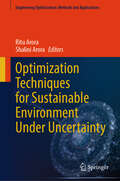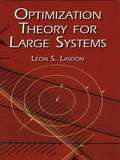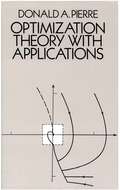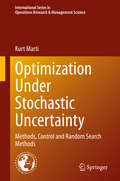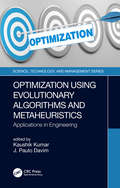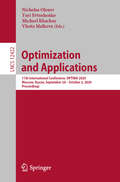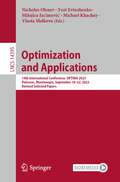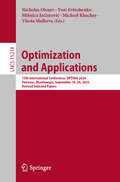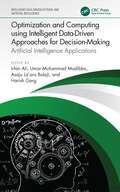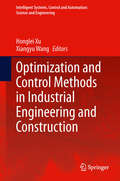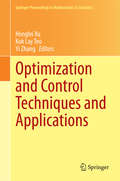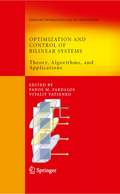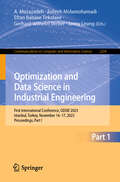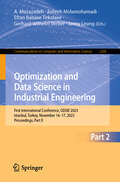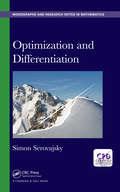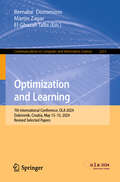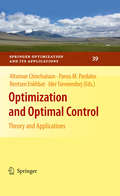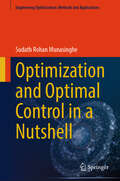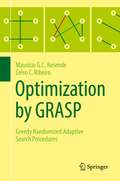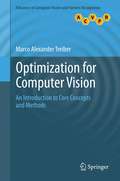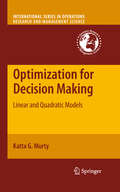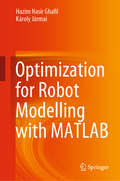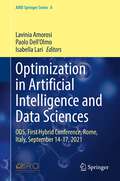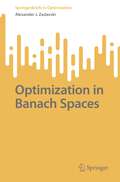- Table View
- List View
Optimization Techniques for Sustainable Environment Under Uncertainty (Engineering Optimization: Methods and Applications)
by Ritu Arora Shalini AroraThe book's objective is to develop mathematical structures that can be applied to real-life problems with sustainable goals. It focuses on the impact of sustainable living on social, economic, and environmental aspects, aiming to create optimization techniques that minimize emissions and maximize green energy. These optimization problems may include sustainable transport, cities, economic development, living, and tourism. The book brings together researchers, academics, and professionals from various fields to find optimal or satisfactory solutions for various environmentally friendly sustainable problems. It aims to achieve this not only with existing optimization techniques, but also with novel approaches such as lexicographic optimization, heuristic approaches, DEA, and genetic algorithms. The goal is to develop practical algorithms and methods applicable to these problems under uncertain circumstances and explore the potential for improving the efficiency of existing algorithms.
Optimization Theory for Large Systems (Dover Books on Mathematics)
by Leon S. LasdonImportant text examines most significant algorithms for optimizing large systems and clarifying relations between optimization procedures. Much data appear as charts and graphs and will be highly valuable to readers in selecting a method and estimating computer time and cost in problem-solving. Initial chapter on linear and nonlinear programming presents all necessary background for subjects covered in rest of book. Second chapter illustrates how large-scale mathematical programs arise from real-world problems. Appendixes. List of Symbols.
Optimization Theory with Applications
by Donald A. PierreOptimization principles are of undisputed importance in modern design and system operation. They can be used for many purposes: optimal design of systems, optimal operation of systems, determination of performance limitations of systems, or simply the solution of sets of equations. While most books on optimization are limited to essentially one approach, this volume offers a broad spectrum of approaches, with emphasis on basic techniques from both classical and modern work.After an introductory chapter introducing those system concepts that prevail throughout optimization problems of all types, the author discusses the classical theory of minima and maxima (Chapter 2). In Chapter 3, necessary and sufficient conditions for relative extrema of functionals are developed from the viewpoint of the Euler-Lagrange formalism of the calculus of variations. Chapter 4 is restricted to linear time-invariant systems for which significant results can be obtained via transform methods with a minimum of computational difficulty. In Chapter 5, emphasis is placed on applied problems which can be converted to a standard problem form for linear programming solutions, with the fundamentals of convex sets and simplex technique for solution given detailed attention. Chapter 6 examines search techniques and nonlinear programming. Chapter 7 covers Bellman's principle of optimality, and finally, Chapter 8 gives valuable insight into the maximum principle extension of the classical calculus of variations.Designed for use in a first course in optimization for advanced undergraduates, graduate students, practicing engineers, and systems designers, this carefully written text is accessible to anyone with a background in basic differential equation theory and matrix operations. To help students grasp the material, the book contains many detailed examples and problems, and also includes reference sections for additional reading.
Optimization Under Stochastic Uncertainty: Methods, Control and Random Search Methods (International Series in Operations Research & Management Science #296)
by Kurt MartiThis book examines application and methods to incorporating stochastic parameter variations into the optimization process to decrease expense in corrective measures. Basic types of deterministic substitute problems occurring mostly in practice involve i) minimization of the expected primary costs subject to expected recourse cost constraints (reliability constraints) and remaining deterministic constraints, e.g. box constraints, as well as ii) minimization of the expected total costs (costs of construction, design, recourse costs, etc.) subject to the remaining deterministic constraints.After an introduction into the theory of dynamic control systems with random parameters, the major control laws are described, as open-loop control, closed-loop, feedback control and open-loop feedback control, used for iterative construction of feedback controls. For approximate solution of optimization and control problems with random parameters and involving expected cost/loss-type objective, constraint functions, Taylor expansion procedures, and Homotopy methods are considered, Examples and applications to stochastic optimization of regulators are given. Moreover, for reliability-based analysis and optimal design problems, corresponding optimization-based limit state functions are constructed. Because of the complexity of concrete optimization/control problems and their lack of the mathematical regularity as required of Mathematical Programming (MP) techniques, other optimization techniques, like random search methods (RSM) became increasingly important.Basic results on the convergence and convergence rates of random search methods are presented. Moreover, for the improvement of the – sometimes very low – convergence rate of RSM, search methods based on optimal stochastic decision processes are presented. In order to improve the convergence behavior of RSM, the random search procedure is embedded into a stochastic decision process for an optimal control of the probability distributions of the search variates (mutation random variables).
Optimization Using Evolutionary Algorithms and Metaheuristics: Applications in Engineering (Science, Technology, and Management)
by J. Paulo Davim Kaushik KumarMetaheuristic optimization is a higher-level procedure or heuristic designed to find, generate, or select a heuristic (partial search algorithm) that may provide a sufficiently good solution to an optimization problem, especially with incomplete or imperfect information or limited computation capacity. This is usually applied when two or more objectives are to be optimized simultaneously. This book is presented with two major objectives. Firstly, it features chapters by eminent researchers in the field providing the readers about the current status of the subject. Secondly, algorithm-based optimization or advanced optimization techniques, which are applied to mostly non-engineering problems, are applied to engineering problems. This book will also serve as an aid to both research and industry. Usage of these methodologies would enable the improvement in engineering and manufacturing technology and support an organization in this era of low product life cycle. Features: Covers the application of recent and new algorithms Focuses on the development aspects such as including surrogate modeling, parallelization, game theory, and hybridization Presents the advances of engineering applications for both single-objective and multi-objective optimization problems Offers recent developments from a variety of engineering fields Discusses Optimization using Evolutionary Algorithms and Metaheuristics applications in engineering
Optimization and Applications: 11th International Conference, OPTIMA 2020, Moscow, Russia, September 28 – October 2, 2020, Proceedings (Lecture Notes in Computer Science #12422)
by Michael Khachay Vlasta Malkova Nicholas Olenev Yuri EvtushenkoThis book constitutes the refereed proceedings of the 11th International Conference on Optimization and Applications, OPTIMA 2020, held in Moscow, Russia, in September-October 2020.*The 21 full and 2 short papers presented were carefully reviewed and selected from 60 submissions. The papers cover such topics as mathematical programming, combinatorial and discrete optimization, optimal control, optimization in economics, finance, and social sciences, global optimization, and applications. * The conference was held virtually due to the COVID-19 pandemic.
Optimization and Applications: 14th International Conference, OPTIMA 2023, Petrovac, Montenegro, September 18–22, 2023, Revised Selected Papers (Lecture Notes in Computer Science #14395)
by Michael Khachay Milojica Jaćimović Vlasta Malkova Nicholas Olenev Yuri EvtushenkoThis book constitutes the refereed proceedings of the 14th International Conference on Optimization and Applications, OPTIMA 2023, held in Petrovac, Montenegro, during September 18–22, 2023.The 27 full papers included in this book were carefully reviewed and selected from 68 submissions. They were organized in topical sections as follows: mathematical programming; global optimization; discrete and combinatorial optimization; game theory and mathematical economics; optimization in economics and finance; and applications.
Optimization and Applications: 15th International Conference, OPTIMA 2024, Petrovac, Montenegro, September 16–20, 2024, Revised Selected Papers (Lecture Notes in Computer Science #15218)
by Michael Khachay Milojica Jaćimović Vlasta Malkova Nicholas Olenev Yuri EvtushenkoThis book constitutes the refereed proceedings of the 15th International Conference on Optimization and Applications, OPTIMA 2024, held in Petrovac, Montenegro, during September 16–20, 2024. The 24 full papers presented in this volume were carefully reviewed and selected from 60 submissions. They are grouped into the following topics: Mathematical Programming; Global Optimization; Optimal Control; Game Theory and Mathematical Economics; Optimization in Economics and Finance; and Applications.
Optimization and Computing using Intelligent Data-Driven Approaches for Decision-Making: Artificial Intelligence Applications (Intelligent Data-Driven Systems and Artificial Intelligence)
by Harish Garg Irfan Ali Umar Muhammad Modibbo Asaju La’aro BolajiThis book comprehensively discusses nature-inspired algorithms, deep learning methods, applications of mathematical programming and artificial intelligence techniques. It will further cover important topic such as linking green supply chain management practices with competitiveness, industry 4.0, and social responsibility.This book: Addresses solving practical problems such as supply chain management, take-off, and healthcare analytics using intelligent computing Presents a comparative analysis of machine learning algorithms for power consumption prediction Discusses a machine learning-based multi-objective optimization technique for load balancing in an integrated fog cloud environment Illustrates a data-driven optimization concept for modeling environmental and economic sustainability Explains the use of heuristics and metaheuristics in supply chain networks and the use of fuzzy optimization in sustainable development goals The text is primarily written for graduate students, and academic researchers in diverse fields including electrical engineering, electronics and communications engineering, mathematics and statistics, computer science and engineering.
Optimization and Control Methods in Industrial Engineering and Construction
by Xiangyu Wang Honglei XuThis book presents recent advances in optimization and control methods with applications to industrial engineering and construction management. It consists of 15 chapters authored by recognized experts in a variety of fields including control and operation research, industrial engineering and project management. Topics include numerical methods in unconstrained optimization, robust optimal control problems, set splitting problems, optimum confidence interval analysis, a monitoring networks optimization survey, distributed fault detection, nonferrous industrial optimization approaches, neural networks in traffic flows, economic scheduling of CCHP systems, a project scheduling optimization survey, lean and agile construction project management, practical construction projects in Hong Kong, dynamic project management, production control in PC4P and target contracts optimization. The book offers a valuable reference work for scientists, engineers, researchers and practitioners in industrial engineering and construction management.
Optimization and Control Techniques and Applications
by Honglei Xu Kok Lay Teo Yi ZhangThis book presents advances in state-of-the-art solution methods and their applications to real life practical problems in optimization, control and operations research. Contributions from world-class experts in the field are collated here in two parts, dealing first with optimization and control theory and then with techniques and applications. Topics covered in the first part include control theory on infinite dimensional Banach spaces, history-dependent inclusion and linear programming complexity theory. Chapters also explore the use of approximations of Hamilton-Jacobi-Bellman inequality for solving periodic optimization problems and look at multi-objective semi-infinite optimization problems and production planning problems. In the second part, the authors address techniques and applications of optimization and control in a variety of disciplines, such as chaos synchronization, facial expression recognition and dynamic input-output economic models. Other applications considered here include image retrieval, natural earth satellites orbital transfers, snap-back repellers and modern logistic systems. Readers will learn of advances in optimization, control and operations research, as well as potential new avenues of research and development. The book will appeal to scientific researchers, mathematicians and all specialists interested in the latest advances in optimization and control.
Optimization and Control of Bilinear Systems
by Panos M. Pardalos Vitaliy A. YatsenkoCovers developments in bilinear systems theory Focuses on the control of open physical processes functioning in a non-equilibrium mode Emphasis is on three primary disciplines: modern differential geometry, control of dynamical systems, and optimization theory Includes applications to the fields of quantum and molecular computing, control of physical processes, biophysics, superconducting magnetism, and physical information science
Optimization and Data Science in Industrial Engineering: First International Conference, ODSIE 2023, Istanbul, Turkey, November 16–17, 2023, Proceedings, Part I (Communications in Computer and Information Science #2204)
by Gerhard-Wilhelm Weber Zohreh Molamohamadi A. Mirzazadeh Efran Babaee Tirkolaee Janny LeungThis two-volume set CCIS 2204 and 2205 constitutes the refereed proceedings of the First International Conference on Optimization and Data Science in Industrial Engineering, ODSIE 2023, held in Istanbul, Turkey, during November 16–17, 2023. The 33 full papers and 2 short papers presented in these proceedings were carefully reviewed and selected from 311 submissions. The papers were organized in the following topical sections: Part I: smart and intelligent transportation systems; machine/deep/reinforcement learning in industries; and advances of artificial intelligence/operational research tools in healthcare. Part II: technology, learning and analytics in intelligent systems; expert systems, decision analysis, and advanced optimization; digital transformation of supply chain and logistics systems.
Optimization and Data Science in Industrial Engineering: First International Conference, ODSIE 2023, Istanbul, Turkey, November 16–17, 2023, Proceedings, Part II (Communications in Computer and Information Science #2205)
by Gerhard-Wilhelm Weber Zohreh Molamohamadi A. Mirzazadeh Efran Babaee Tirkolaee Janny LeungThis two-volume set CCIS 2204 and 2205 constitutes the refereed proceedings of the First International Conference on Optimization and Data Science in Industrial Engineering, ODSIE 2023, held in Istanbul, Turkey, during November 16–17, 2023. The 33 full papers and 2 short papers presented in these proceedings were carefully reviewed and selected from 311 submissions. The papers were organized in the following topical sections: Part I: smart and intelligent transportation systems; machine/deep/reinforcement learning in industries; and advances of artificial intelligence/operational research tools in healthcare. Part II: technology, learning and analytics in intelligent systems; expert systems, decision analysis, and advanced optimization; digital transformation of supply chain and logistics systems.
Optimization and Differentiation (Chapman & Hall/CRC Monographs and Research Notes in Mathematics)
by Simon SerovajskyOptimization and Differentiation is an introduction to the application of optimization control theory to systems described by nonlinear partial differential equations. As well as offering a useful reference work for researchers in these fields, it is also suitable for graduate students of optimal control theory.
Optimization and Learning: 7th International Conference, OLA 2024, Dubrovnik, Croatia, May 13–15, 2024, Revised Selected Papers (Communications in Computer and Information Science #2311)
by Bernabé Dorronsoro El-Ghazali Talbi Martin ZagarThis book constitutes the refereed proceedings of the 7th International Conference on Optimization and Learning, OLA 2024, held in Dubrovnik, Croatia, during May 13–15, 2024. The 24 full papers presented here were carefully reviewed and selected from 64 submissions. They were organized in the following topical sections: synergies between optimization and machine learning; enhancing optimization and learning techniques; transportation and routing; and applications.
Optimization and Optimal Control
by Panos M. Pardalos Ider Tseveendorj Altannar Chinchuluun Rentsen EnkhbatOptimization and optimal control are the main tools in decision making. Because of their numerous applications in various disciplines, research in these areas is accelerating at a rapid pace. "Optimization and Optimal Control: Theory and Applications" brings together the latest developments in these areas of research as well as presents applications of these results to a wide range of real-world problems. This volume can serve as a useful resource for researchers, practitioners, and advanced graduate students of mathematics and engineering working in research areas where results in optimization and optimal control can be applied.
Optimization and Optimal Control in a Nutshell (Engineering Optimization: Methods and Applications)
by Sudath Rohan MunasingheThis book concisely presents the optimization process and optimal control process with examples and simulations to help self-learning and better comprehension. It starts with function optimization and constraint inclusion and then extends to functional optimization using the calculus of variations. The development of optimal controls for continuous-time, linear, open-loop systems is presented using Lagrangian and Pontryagin-Hamiltonian methods, showing how to introduce the end-point conditions in time and state. The closed-loop optimal control for linear systems with a quadratic cost function, well-known as the linear quadratic regulator (LQR) is developed for both time-bound and time-unbounded conditions. Some control systems need to maximize performance alongside cost minimization. The Pontryagin's maximum principle is presented in this regard with clear examples that show the practical implementation of it. It is shown through examples how the maximum principle leads to control switching and Bang-Bang control in certain types of systems. The application of optimal controls in discrete-time open-loop systems with the quadratic cost is presented and then extended to the closed-loop control, which results in the model predictive control (MPC). Throughout the book, examples and Matlab simulation codes are provided for the learner to practice the contents in each section. The aligned lineup of content helps the learner develop knowledge and skills in optimal control gradually and quickly.
Optimization by GRASP: Greedy Randomized Adaptive Search Procedures
by Celso C. Ribeiro Mauricio G.C. ResendeThis is the first book to cover GRASP (Greedy Randomized Adaptive Search Procedures), a metaheuristic that has enjoyed wide success in practice with a broad range of applications to real-world combinatorial optimization problems. The state-of-the-art coverage and carefully crafted pedagogical style lends this book highly accessible as an introductory text not only to GRASP, but also to combinatorial optimization, greedy algorithms, local search, and path-relinking, as well as to heuristics and metaheuristics, in general. The focus is on algorithmic and computational aspects of applied optimization with GRASP with emphasis given to the end-user, providing sufficient information on the broad spectrum of advances in applied optimization with GRASP. For the more advanced reader, chapters on hybridization with path-relinking and parallel and continuous GRASP present these topics in a clear and concise fashion. Additionally, the book offers a very complete annotated bibliography of GRASP and combinatorial optimization. For the practitioner who needs to solve combinatorial optimization problems, the book provides a chapter with four case studies and implementable templates for all algorithms covered in the text. This book, with its excellent overview of GRASP, will appeal to researchers and practitioners of combinatorial optimization who have a need to find optimal or near optimal solutions to hard combinatorial optimization problems.
Optimization for Computer Vision: An Introduction to Core Concepts and Methods
by Marco Alexander TreiberThis practical and authoritative text/reference presents a broad introduction to the optimization methods used specifically in computer vision. In order to facilitate understanding, the presentation of the methods is supplemented by simple flow charts, followed by pseudocode implementations that reveal deeper insights into their mode of operation. These discussions are further supported by examples taken from important applications in computer vision. Topics and features: provides a comprehensive overview of computer vision-related optimization; covers a range of techniques from classical iterative multidimensional optimization to cutting-edge topics of graph cuts and GPU-suited total variation-based optimization; describes in detail the optimization methods employed in computer vision applications; illuminates key concepts with clearly written and step-by-step explanations; presents detailed information on implementation, including pseudocode for most methods.
Optimization for Data Analysis
by Stephen J. Wright Benjamin RechtOptimization techniques are at the core of data science, including data analysis and machine learning. An understanding of basic optimization techniques and their fundamental properties provides important grounding for students, researchers, and practitioners in these areas. This text covers the fundamentals of optimization algorithms in a compact, self-contained way, focusing on the techniques most relevant to data science. An introductory chapter demonstrates that many standard problems in data science can be formulated as optimization problems. Next, many fundamental methods in optimization are described and analyzed, including: gradient and accelerated gradient methods for unconstrained optimization of smooth (especially convex) functions; the stochastic gradient method, a workhorse algorithm in machine learning; the coordinate descent approach; several key algorithms for constrained optimization problems; algorithms for minimizing nonsmooth functions arising in data science; foundations of the analysis of nonsmooth functions and optimization duality; and the back-propagation approach, relevant to neural networks.
Optimization for Decision Making
by Katta G. MurtyLinear programming (LP), modeling, and optimization are very much the fundamentals of OR, and no academic program is complete without them. No matter how highly developed one's LP skills are, however, if a fine appreciation for modeling isn't developed to make the best use of those skills, then the truly 'best solutions' are often not realized, and efforts go wasted. Katta Murty studied LP with George Dantzig, the father of linear programming, and has written the graduate-level solution to that problem. While maintaining the rigorous LP instruction required, Murty's new book is unique in his focus on developing modeling skills to support valid decision making for complex real world problems. He describes the approach as 'intelligent modeling and decision making' to emphasize the importance of employing the best expression of actual problems and then applying the most computationally effective and efficient solution technique for that model.
Optimization for Robot Modelling with MATLAB
by Károly Jármai Hazim Nasir GhafilThis book addresses optimization in robotics, in terms of both the configuration space and the metal structure of the robot arm itself; and discusses, describes and builds different types of heuristics and algorithms in MATLAB. In addition, the book includes a wealth of examples and exercises. In particular, it enables the reader to write a MATLAB code for all the related problems in robotics. The book also offers detailed descriptions of and builds from scratch several types of optimization algorithms using MATLAB and simplified methods, especially for inverse problems and avoiding singularities. Each chapter features examples and exercises to enhance the reader’s comprehension. Accordingly, the book offers the reader a better understanding of robot analysis from an optimization standpoint.
Optimization in Artificial Intelligence and Data Sciences: ODS, First Hybrid Conference, Rome, Italy, September 14-17, 2021 (AIRO Springer Series #8)
by Paolo Dell’Olmo Lavinia Amorosi Isabella LariThis book is addressed to researchers in operations research, data science and artificial intelligence. It collects selected contributions from the first hybrid “Optimization and Decision Science - ODS2021” international conference on the theme Optimization and Artificial Intelligence and Data Sciences, which was held in Rome 14-17 September 2021 and organized by AIRO, the Italian Operations Research Society and the Department of Statistical Sciences of Sapienza University of Rome. The book offers new and original contributions on different methodological optimization topics, from Support Vector Machines to Game Theory Network Models, from Mathematical Programming to Heuristic Algorithms, and Optimization Methods for a number of emerging problems from Truck and Drone delivery to Risk Assessment, from Power Networks Design to Portfolio Optimization. The articles in the book can give a significant edge to the general themes of sustainability and pollution reduction, distributive logistics, healthcare management in pandemic scenarios and clinical trials, distributed computing, scheduling, and many others. For these reasons, the book is aimed not only at researchers in the Operations Research community but also for practitioners facing decision-making problems in these areas and to students and researchers from other disciplines, including Artificial Intelligence, Computer Sciences, Finance, Mathematics, and Engineering.
Optimization in Banach Spaces (SpringerBriefs in Optimization)
by Alexander J. ZaslavskiThe book is devoted to the study of constrained minimization problems on closed and convex sets in Banach spaces with a Frechet differentiable objective function. Such problems are well studied in a finite-dimensional space and in an infinite-dimensional Hilbert space. When the space is Hilbert there are many algorithms for solving optimization problems including the gradient projection algorithm which is one of the most important tools in the optimization theory, nonlinear analysis and their applications. An optimization problem is described by an objective function and a set of feasible points. For the gradient projection algorithm each iteration consists of two steps. The first step is a calculation of a gradient of the objective function while in the second one we calculate a projection on the feasible set. In each of these two steps there is a computational error. In our recent research we show that the gradient projection algorithm generates a good approximate solution, if all the computational errors are bounded from above by a small positive constant. It should be mentioned that the properties of a Hilbert space play an important role. When we consider an optimization problem in a general Banach space the situation becomes more difficult and less understood. On the other hand such problems arise in the approximation theory. The book is of interest for mathematicians working in optimization. It also can be useful in preparation courses for graduate students. The main feature of the book which appeals specifically to this audience is the study of algorithms for convex and nonconvex minimization problems in a general Banach space. The book is of interest for experts in applications of optimization to the approximation theory.In this book the goal is to obtain a good approximate solution of the constrained optimization problem in a general Banach space under the presence of computational errors. It is shown that the algorithm generates a good approximate solution, if the sequence of computational errors is bounded from above by a small constant. The book consists of four chapters. In the first we discuss several algorithms which are studied in the book and prove a convergence result for an unconstrained problem which is a prototype of our results for the constrained problem. In Chapter 2 we analyze convex optimization problems. Nonconvex optimization problems are studied in Chapter 3. In Chapter 4 we study continuous algorithms for minimization problems under the presence of computational errors. The algorithm generates a good approximate solution, if the sequence of computational errors is bounded from above by a small constant. The book consists of four chapters. In the first we discuss several algorithms which are studied in the book and prove a convergence result for an unconstrained problem which is a prototype of our results for the constrained problem. In Chapter 2 we analyze convex optimization problems. Nonconvex optimization problems are studied in Chapter 3. In Chapter 4 we study continuous algorithms for minimization problems under the presence of computational errors.
